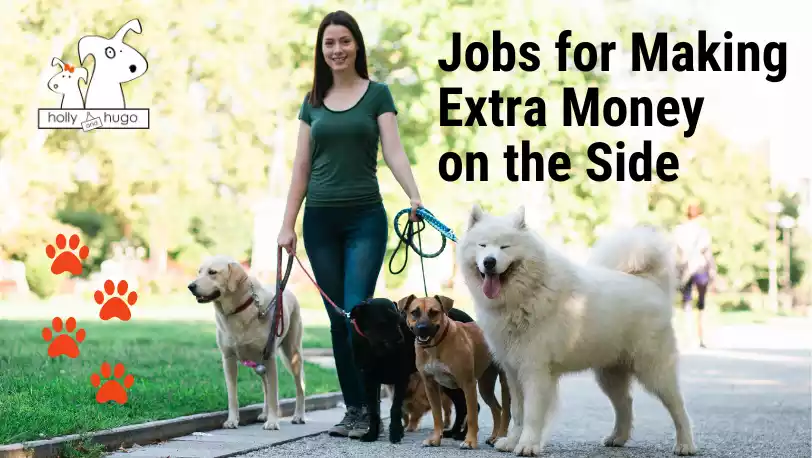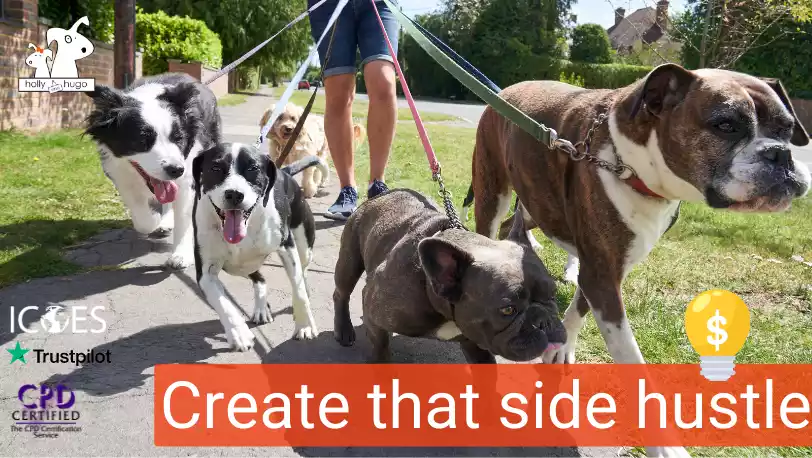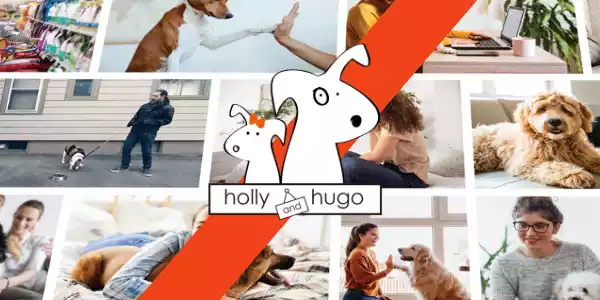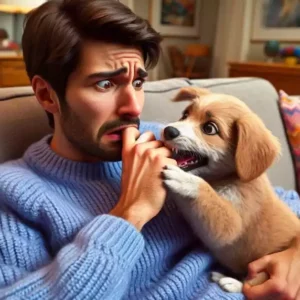Puppy Potty training : From Puddles to Perfection: Conquering Panic in 7 Easy Steps
Imagine this: You finally bring home your fluffy dream puppy, a bundle of wagging tails, wet noses, and… accidents.
Suddenly, your pristine floors transform into a minefield of tiny puddles, and the scent of “Eau de Puppy” replaces your carefully curated aromatherapy. (Cue montage of exasperated sighs and frantic mopping!)
Been there, done that (and scrubbed the carpets)? You’re not alone. Housebreaking a new puppy can feel like wrestling a hurricane in a teacup. But fear not, fellow dog lovers!
This is your battle cry, your potty-training manifesto! Forget the stress, ditch the desperation. We’re about to embark on a journey of transformation, where chaotic puddles morph into triumphant “good potty!” celebrations.
In just 7 easy steps, we’ll unlock the secrets to puppy potty perfection. Prepare to understand your pup’s little bladder, craft a foolproof schedule, and unleash the power of positive reinforcement.
We’ll navigate common mishaps like nighttime misadventures and chewing distractions, leaving you both feeling confident and paw-sitively triumphant.
So, grab your treats, leash up your patience, and get ready to witness the magic of a well-trained pup. From messy mayhem to joyful puddles of praise, let’s rewrite the bathroom blues and paint your home with the vibrant hues of puppy-parent harmony.
Ready to ditch the diapers and celebrate your pup’s potty prowess? Dive into our step-by-step guide and let the “good boy/girl” chorus commence!
Table of Contents
Decoding the Doodle Dilemma: Understanding Your Puppy’s Bladder Control
Bringing home a bouncy ball of fluff might have you dreaming of endless games of fetch and snuggle sessions.
But before you paint visions of a perfectly housebroken pup, it’s essential to take a peek into the fascinating world of puppy development, specifically, their little bladders.
Understanding how their bodies work is the first step in building a successful potty training strategy.
Puppyhood Unfurled: A Bladder Timeline
Imagine your new puppy as a tiny explorer constantly learning about the world, one wagging tail and curious sniff at a time.
But just like your own bladder control developed gradually, so does theirs. Think of it as a bladder-blooming journey:
- Newborn to 4 weeks: Tiny, undeveloped bladders mean frequent elimination, roughly every 30-60 minutes. They don’t yet have control, so accidents are inevitable. Patience and frequent trips outside are key!
- 4-8 weeks: Muscles begin to develop, allowing them to hold it for about 1-2 hours. Routines start becoming important, as consistency helps them predict elimination needs.
- 8-12 weeks: The magic number is 2! Most puppies can now hold it for around 2 hours per month of age. Celebrate victories, but remember, occasional mishaps are still par for the course.
- 12 weeks and beyond: With continued guidance and reinforcement, your pup’s bladder control blossoms. Expect potty breaks every 3-4 hours, gradually increasing with age and training.
Remember, this is just a general timeline, and every puppy develops at their own pace.
Some factors, like breed and health, can influence bladder control development.
The key is to be patient, observant, and adjust your expectations based on your unique furry friend.
The Big “Why” Behind Those Tiny Puddles
While pee puddles might seem like random explosions of chaos, there’s often a reason behind them. Understanding these triggers can help you anticipate needs and prevent accidents:
- Food and water influx: After meals and hydration, puppies need to be eliminated more frequently. Schedule potty breaks 15-30 minutes after eating and drinking.
- Playtime excitement: A whirlwind of fetch and zoomies can send bladder control into overdrive. Keep an eye on your pup during playtime and head outside for quick breaks.
- Wake-up and sleepy calls: Just like us, puppies need to be eliminated after naps and upon waking up. These are prime potty break opportunities!
- Stress and new environments: Unfamiliar places or stressful situations can trigger accidents. Be extra attentive when visiting new spaces or introducing new people.
By recognizing these triggers and establishing consistent routines around them, you’ll set your puppy up for success and transform those puddles into predictable potty breaks.
Remember, knowledge is power, and understanding your pup’s little bladder is the first step towards a clean and joyful home.
From Blank Canvas to Masterpiece: Crafting the Perfect Potty-Training Paradise
Congratulations, you’ve unlocked the secrets of your puppy’s bladder! Now, it’s time to transform your home into a potty-training paradise, a haven where accidents are banished and “good job!” echoes through the halls.
Remember, setting the stage for success is crucial, so let’s equip you with the essentials:
The Arsenal of an Ace Potty Trainer: Essential Supplies
Think of yourself as a potty-training knight, embarking on a noble quest. Just like any valiant hero, you need the right tools:
- Leashes and harnesses: For safe and guided outdoor trips, ensuring your pup can’t explore off-limits territory.
- Puppy gates and playpens: To create designated potty-free zones and confine your pup to areas easier to clean.
- Puppy pads: For emergencies or times when immediate outdoor access isn’t possible. Choose absorbent, leak-proof options and place them in specific, consistent locations.
- Enzymes and cleaning products: Accidents happen, so be prepared with specialized cleaners that neutralize odors and deter future marking.
- High-value treats and toys: Positive reinforcement is key! Stock up on your pup’s favorite rewards for celebrating successful eliminations outside.
Remember, quality matters. Invest in durable, comfortable leashes and harnesses, and find puppy pads with minimal environmental impact.
Opt for cleaning products specifically designed for pet messes, and choose treats that are healthy and delicious. Your furry knight deserves the best tools for their potty-training quest!
The Designated Throne: Choosing the Perfect Potty Spot
Think of it as the palace your pup returns to after adventures, a place of relief and accomplishment. Choosing the right potty spot is essential:
- Accessibility: Opt for an easily accessible outdoor area, preferably grassy and away from busy walkways or play zones.
- Consistency is key: Once you’ve chosen a spot, stick to it! Familiar surroundings will help your pup learn and avoid confusion.
- Size matters: Make sure the area is large enough for your pup to comfortably maneuver and eliminate, but not so spacious that they lose track of where to go.
- Sensory cues: Consider using visual markers like flags or small posts near the potty spot to help your pup remember its location.
Creating a dedicated potty haven makes outdoor trips smooth and predictable. Remember, consistency is your greatest ally.
Once your pup knows their designated throne, accidents become a distant memory, and your home transforms into a potty-training palace worthy of a furry champion!
From Chaos to Clockwork: Building a Potty-Training Rhythm That Rocks
Ah, the symphony of a well-trained pup – the pitter-patter of tiny paws rushing to the door, the excited wag that precedes a triumphant “good potty!”, the blissful absence of puddles underfoot.
It all starts with one thing: rhythm. Think of it as a beautiful melody you compose together, a predictable song of nature’s calls and timely outdoor trips. Let’s orchestrate this harmony, shall we?
Frequency First: The Symphony of Potty Breaks
Remember the bladder timeline we explored earlier? Well, it’s time to put that knowledge into practice by establishing a schedule that respects your pup’s developing control.
Think of it as setting the tempo for your potty-training symphony:
- Newborn to 4 weeks: A whirlwind of every 30-60 minutes is your reality. Embrace the frequent trips, set alarms, and make it a bonding adventure!
- 4-8 weeks: We’re stretching it out to 1-2 hours! Stick to a consistent routine, especially after meals, naps, and playtime. Celebrate victories, but be prepared for occasional off-key notes.
- 8-12 weeks: The magic number 2 arrives! Aim for potty breaks every 2-3 hours, gradually increasing as your pup matures. Consistency is still king, so keep those trips predictable.
- 12 weeks and beyond: You’re nearing the grand finale! Expect breaks every 3-4 hours, with gradual increases based on your pup’s individual needs. Remember, flexibility is key – adjust the tempo if you sense any wobbly notes.
This schedule is a starting point, not a rigid rulebook. Pay attention to your pup’s individual cues – sniffing, circling, whining – and adjust the breaks accordingly.
Remember, consistency is your metronome, but flexibility is your backup instrument. Together, you’ll find the perfect rhythm for your potty-training masterpiece.
Leashed and Focused: The Power of Outdoor Podiums
Think of the leash as your magic conductor’s baton, guiding your pup towards the outdoor “potty podium” where accidents transform into applause. Leash-guided trips offer numerous benefits:
- Focused attention: By keeping your pup on a leash, you minimize distractions and prevent them from “forgetting” to eliminate outdoors.
- Clear destination: The leash becomes a physical tether, leading them directly to the designated potty area, reducing confusion and missed opportunities.
- Positive reinforcement: Celebrate successful eliminations on the leash with enthusiastic praise and high-value treats. This association strengthens the “good potty = good things” link in their minds.
Remember, unleashing freedom comes later. For now, embrace the power of leash-guided trips. It’s not about restricting your pup, but about guiding them towards potty-training success, one triumphant “plop” at a time!
From Puddles to Party Time: The Magic of Positive Reinforcement in Potty Training
Imagine this: your puppy eliminates indoors, and your response is a thunderous storm of scolding and frustration.
Not only is this approach ineffective, but it can damage your bond and even exacerbate the problem.
So, let’s ditch the storm clouds and embrace sunshine! Positive reinforcement is the secret weapon of successful potty training, transforming puddles into party time celebrations and building a joyful, productive learning experience for both you and your furry friend.
Praise Power: Applause for Every Plop
Think of your pup as a tiny performer on the potty-training stage. Every successful elimination deserves a standing ovation:
- Verbal cues: Shower your pup with enthusiastic praise! “Good potty!”, “Excellent elimination!”, “You’re a potty pro!” – let your voice brim with joy and excitement.
- Treat time is party time: Unleash the power of high-value treats, their favorite chew toy, or a playful cuddle session. Make these rewards instantly following the elimination to solidify the positive association.
- Body language matters: Get on your pup’s level, offer gentle scratches, and shower them with affection. Show them you’re genuinely proud of their accomplishment.
Remember, timing is everything! Celebrate within seconds of the elimination for maximum impact. The faster your pup associates “doing it outside” with a burst of positive reinforcement, the quicker they’ll grasp the potty-training concept.
Ditch the Drama: Why Scolding Backfires
Negative reinforcement might seem tempting, but it’s a surefire way to derail your potty-training progress. Here’s why yelling, scolding, or punishing your pup is counterproductive:
- Fear and confusion: Your pup doesn’t understand why they’re being punished, potentially associating elimination with negativity and anxiety, leading to more accidents.
- Damaged bond: Scolding can erode the trust and positive relationship you’re building with your pup, making the training process even more challenging.
- Focus on the wrong thing: Instead of learning where and when to eliminate, your pup becomes preoccupied with avoiding your displeasure, leading to unpredictable behavior.
Remember, patience and positive reinforcement are the cornerstones of successful potty training.
Embrace every opportunity to celebrate your pup’s progress, and trust that consistent positive reinforcement will guide them towards the “good potty” chorus you long to hear.
From Oops to Ah-Ha! Conquering Potty-Training Hiccups with Grace
Even the most dedicated potty-training warriors encounter unexpected challenges.
Don’t let the occasional “oopsie” derail your progress! Instead, view these hiccups as opportunities for learning and adjustment.
Let’s tackle some common roadblocks and equip you with the knowledge to transform setbacks into stepping stones towards successful potty-training:
Nighttime Navigators: Banishing Midnight Messes
Ah, the allure of a cozy bed… even for tiny bladders. Nighttime accidents can be frustrating, but with the right approach, you can transform your pup into a nocturnal potty pro:
- Limit water intake before bedtime: While hydration is crucial, reducing water access in the evening hours can minimize the need for urgent eliminations during the night.
- Late-night potty break: Before turning in, take your pup out for one last trip, even if they seem content. Remember, small bladders hold less!
- Crate training for containment: Utilizing a cozy crate can help prevent nighttime accidents. Make sure it’s the right size, not too big, and create a positive association with the crate through playtime and treats.
Remember, accidents happen, especially during the early stages. Be patient, avoid scolding, and celebrate successes, even if they happen at 3 AM! Consistency and perseverance will gradually train your pup’s bladder to hold it through the night.
Chewing the Blues: Redirecting Destructive Distractions
Sometimes, enthusiastic chewing becomes the nemesis of potty training. Don’t despair! This behavior often stems from boredom, teething, or anxiety, and can be redirected:
- Provide ample chew toys: Offer a variety of safe, engaging chew toys made from different materials to satisfy your pup’s natural chewing urge. Rotate the toys regularly to keep them interesting.
- Channel the gnawing: Redirect chewing towards appropriate outlets like frozen carrots, bully sticks, or specially designed chew toys. Praise your pup when they engage with these alternatives.
- Identify stress triggers: Is your pup chewing more during thunderstorms or when left alone? Address the underlying anxiety through positive reinforcement strategies and desensitization training.
Remember, chewing during potty training doesn’t necessarily mean regression. Be patient, offer appropriate outlets, and address any underlying triggers to help your pup overcome this destructive behavior.
Regression Revelations: Bouncing Back from Setbacks
Even the most promising potty-training journeys can experience occasional backslides. Don’t panic! Regression is often temporary and can be caused by various factors:
- Illness or stress: Changes in your pup’s health or environment can trigger temporary setbacks. Provide extra care and attention during these times, and adjust your potty training schedule as needed.
- Missed cues or schedule disruptions: Ensure you’re attentive to your pup’s elimination cues and stick to your established routine as much as possible. Missed breaks or inconsistent schedules can lead to accidents.
- Underlying medical issues: In some cases, frequent accidents might indicate a medical condition like urinary tract infections. Consult your veterinarian if you suspect any health concerns.
Remember, regression is not a failure, but a learning opportunity. Recommit to your positive reinforcement strategies, review your schedule and routines, and address any underlying causes.
With patience and consistent effort, you and your pup will bounce back from setbacks and continue your journey towards potty-training success.
From Puddles to Parade: Celebrating Your Housebreaking Triumph!
The day arrives. No more frantic dashes to mop up “presents,” no more holding your breath during playtime, no more resigned sighs at tiny puddles disrupting your pristine floors.
Your pup has mastered the magical art of “holding it” and eliminating outdoors, transforming your home from a chaotic minefield to a haven of blissful, puddle-free harmony.
It’s time to celebrate, to throw a confetti parade for your furry graduate, and to revel in the sweet victory of successful housebreaking!
Gradual Growth: Expanding Freedom with Confidence
Remember those days of hourly trips outside, armed with treats and endless patience? You’ve come a long way, both you and your pup! Now, it’s time to reward progress and gradually increase your pup’s freedom:
- Longer leash walks: With consistent success, extend your outdoor trips, allowing your pup more time to explore and sniff while maintaining the leash connection for guidance.
- Unleashing in familiar spaces: Once leash walks are mastered, graduate to safe, enclosed areas like your backyard. Start with short periods initially, gradually increasing playtime without the leash tether.
- Building trust inside: As your pup demonstrates consistent control, designate certain “pee-free zones” indoors where they can roam freely without supervision. Remember, trust is earned, so reward continued success with plenty of praise and attention.
Remember, progress is gradual, and setbacks can happen. If accidents occur, don’t despair! Simply revert to a slightly stricter schedule for a while, address any potential triggers, and recommit to positive reinforcement.
Your pup is still learning, and your unwavering support is key to their continued success.
The “Good Potty” Chorus: Maintaining the Magic with Joy
Remember the symphony of joyful praise you unleashed after successful eliminations? Don’t stop the music just yet! Continued positive reinforcement is crucial for maintaining momentum:
- Keep the party going: Celebrate every “good potty” with the same enthusiasm you did in the beginning. Treats, praise, and playful interactions solidify the positive association with eliminating outdoors.
- Variety is the spice of life: Mix up your rewards! Rotate the treats, offer different types of praise, and introduce engaging games after successful eliminations to keep your pup motivated.
- Forever a team: Remember, housebreaking is a journey, not a destination. Continue to bond with your pup, build trust through play and affection, and let them know you’re their partner in potty-training success.
Your unwavering support and positive reinforcement will not only maintain your pup’s good habits but also deepen your bond, creating a joyful, harmonious relationship built on mutual respect and understanding.
Conclusion: From Pup to Potty Pro: Embracing the Journey and Beyond
So, there you have it! From deciphering your pup’s bladder to celebrating puddle-free paradises, this guide has equipped you with the knowledge and tools to transform your home into a potty-training haven.
Remember, patience is your key, positive reinforcement your magic wand, and consistency your guiding star.
Embrace the journey, celebrate every “good potty” along the way, and revel in the joy of building a bond of trust and understanding with your furry companion.
Now, go forth and unleash your inner potty-training champion! Remember, there will be spills (literally and figuratively), but with consistent effort and unwavering love, you and your pup will emerge victorious, your home transformed into a testament to your shared success.
Don’t forget to shower your furry graduate with extra cuddles and praise; after all, conquering puddles together is just the beginning of your lifelong adventure!
Remember, you’re not alone! If you encounter any bumps on the road, don’t hesitate to reach out to fellow dog lovers, experienced trainers, or your veterinarian. A supportive community and professional guidance can make all the difference in your potty-training journey.












